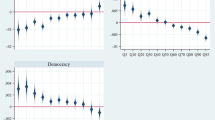Abstract
This paper investigates the relationship between political instability and per capita GDP growth in a sample of 113 countries for the period 1950 through 1982. We define political instability as the propensity of a government collapse, and we estimate a model in which such a measure of political instability and economic growth are jointly determined. The main result of this paper is that in countries and time periods with a high propensity of government collapse, growth is significantly lower than otherwise. We also discuss the effects of different types of government changes on growth.
Similar content being viewed by others
References
Aizenman, J., and N. Marion. (1993). “Policy Uncertainty, Persistence and Growth.” Review of International Economics 1, 145–163.
Alesina, A., J. Londregan, and H. Rosenthal. (1993). “A Model of the Political Economy of the United States.” American Political Science Review 87, 12–33.
Alesina, A., and R. Perotti. (1996). “Political Instability, Income distribution and Investment.” European Economic Review. Forthcoming.
Alesina, A., and H. Rosenthal. (1995). Partisan Politics, Divided Government and the Economy. Cambridge: Cambridge University Press.
Alesina, A., S. Özler, N. Roubini, and P. Swagel. (1992). “Political Instability and Economic Growth.” Working Paper 4173, National Bureau of Economic Research.
Amemiya, T. (1978). “The Estimation of a Simultaneous Equation Generalized Probit Model.” Econometrica 46, 1193–1206.
Banks, A. (Various years). Political Handbook of the World. Various issues.
Barro, R. (1991). “Economic Growth in a Cross Section of Countries.” Quarterly Journal of Economics 106, 407–444.
Barro, R. (1996). “Democracy and Growth.” Journal of Economic Growth 1, 1–27.
Benhabib, J., and M. Spiegel. (1994). “The Role of Human Capital in Economic Development: Evidence From Aggregate Cross Country Data.” Journal of Monetary Economics 34, 143–179.
Cukierman, A., S. Edwards, and G. Tabellini. (1992). “Seigniorage and Political Instability.” American Economic Review 82, 537–555.
Easterly, W., and S. Rebelo. (1993). “Fiscal Policy and Economic Growth: An Empirical Investigation.” Journal of Monetary Economics, 32.
Edwards, S., and G. Tabellini. (1991). “Explaining Fiscal Policies and Inflation in Developing Countries.” Journal of International Money and Finance 10, 835–857.
Fair, R. (1978). “The Effects of Economic Events on Votes for Presidents.” Review of Economics and Statistics 60, 159–172.
Fiorina, M. (1981). Retrospective Voting in American National Elections. New Haven, CT: Yale University Press.
Goodrich, S. (1992). “Political Instability as a Determinant of U.S. Foreign Direct Investment.” Senior thesis, Harvard University.
Grossman, H. (1991). “A General Equilibrium Theory of Insurrections.” American Economic Review 81, 912–921.
Gupta, D. (1990). The Economics of Political Violence. New York: Praeger.
Helliwell, J. (1994). “Empirical Linkages Between Democracy and Growth.” British Journal of Political Science 24, 225–248.
Hibbs, D. (1973). MassPolitical Violence: A Cross-Sectional Analysis. New York: Wiley.
Huntington, S. (1968). Political Order in Changing Societies. New Haven, CT: Yale University Press.
Jodice, D., and D. L. Taylor. (1983). World Handbook of Social and Political Indicators. New Haven: Yale University Press.
Kormendi, R. C., and P. G. Mcguire. (1985). “Macroeconomic Determinants of Growth: Cross-Country Evidence.” Journal of Monetary Economics 16, 141–164.
Kramer, G. (1971). “Short Term Fluctuations in U.S. Voting Behavior, 1896–1964.” American Political Science Review 65, 131–143.
Lewis-Beck, M. (1988). Economics and Elections. Ann Arbor: University of Michigan Press.
Londregan, J., and K. Poole. (1990). “Poverty, the Coup Trap, and the Seizure of Executive Power.” World Politics 42, 151–183.
Londregan, J., and K. Poole. (1991a). “The Seizure of Executive Power and Economic Growth: Some Additional Evidence.” Unpublished paper.
Londregan, J., and K. Poole. (1991b). “Leadership Turnover and Unconstitutional Rule.” Unpublished paper.
Mauro, P. (1993). “Country Risk and Growth: An Empirical Study Based Upon Subjective indices.” Unpublished paper, Harvard University.
Murphy, K., A. Shleifer, and Vishny. (1991). “The Allocation of Talent: Implications for Growth.” Quarterly Journal of Economics 106, 503–530.
Newey, W. K. (1987). “Efficient Estimation of Limited Dependent Variable Models with Endogenous Explanatory Variables.” Journal of Econometrics 36, 231–250.
Olson, M. (1982). The Rise and Decline of Nations: Economic Growth, Stagflation and Social Rigidities. New Haven: Yale University Press.
Ozler, S., and G. Tabellini. (1991). “External Debt and Political Instability.” Working paper, National Bureau of Economic Research.
Robertson (1983). “Inflation, Unemployment and Government Collapse.” Comparative Political Studies 15, 35–47.
Rodrik, D. (1991). “Policy Uncertainty and Private Investment in Developing Countries.” Journal of Development Economics 36, 227–249.
Roubini, N. (1991). “Economic and Political Determinants of Budget Deficits in Developing Countries.” Journal of International Money and Finance, 10, 549–572.
Shleifer, A., and R. Vishny. (1993). “Corruption.” Quarterly Journal of Economics 108, 599–618.
Summers, R., and A. Heston. (1991). “The Penn World Table (Mark 5): An Expanded Set of International Comparisons, 1950–1988.” Review of Income and Wealth, 34, 1–26.
Terrones, M. (1989). “Influence Activities and Economic Growth.” Unpublished paper.
Author information
Authors and Affiliations
Rights and permissions
About this article
Cite this article
Alesina, A., Özler, S., Roubini, N. et al. Political instability and economic growth. J Econ Growth 1, 189–211 (1996). https://doi.org/10.1007/BF00138862
Issue Date:
DOI: https://doi.org/10.1007/BF00138862




